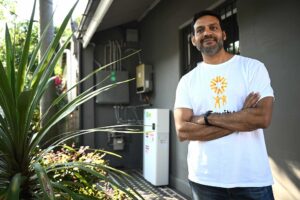Don Harwin, the energy minister of the NSW Coalition government, has made a dramatic departure from the bulk of his state and federal colleagues by declaring that it was time to move on from the notion of “baseload” power as essential to the reliability of the future grid.
In an extraordinary speech to a CEDA energy function in Sydney on Thursday, Harwin looked back on his few months as energy minister, and underlined the huge gap between moderates such as himself looking to embrace new technologies and the conservatives locked into the past.
He particularly focused on the heatwave in February and the events that followed it, including major load-shedding for customers such as the Tomago aluminium smelter.
“There’s no better way to understand how an energy market works and doesn’t work than a heatwave,” Harwin said.
Indeed, were it not for the solid performance of solar, he noted, and other renewables, and the “demand response” from consumers volunteering to reduce the load, the result could have been much worse.
“Clean energy performed as forecast. Thermal generation did not,” Harwin said.
Indeed, some 2GW of coal and gas capacity went missing at the critical moments in NSW when demand hit its peak in early February – around 1GW from the Liddell coal generator and more than 1GW from the two biggest gas generators.
More capacity was lost from other coal plants due to heat stress, and Harwin said there were questions about the ability of fossil fuel generators to perform in the heat, and of the reliability of coal and gas supplies.
This experience, and the arrival of new technologies, and new thinking about energy systems, demanded a rethink.
“Our old paradigm was based upon a notion of a baseload of energy demand being supplied by large thermal generators, and then a peak,” Harwin said. “Over the coming decades, this will change.”
This view is almost completely at odds with conservative members of the Coalition in federal and other state parliaments, many of whom are calling for new coal generators to supply “baseload” and guarantee reliability and low cost.
Numerous reports however have pointed out that large coal generators are neither low cost, nor should baseload be confused with “reliability.”
The Australian Energy Market Operator has embraced these views, and its latest electricity forecasts focus almost entirely on the benefits of distributed generation, small units scattered around the country, like rooftop solar PV, and backed up by battery storage.
And it is looking to key “demand side” responses such as its demand management initiatives currently being introduced in NSW, Victoria and South Australia, and energy efficiency. Together, they can reduce demand by around a third, and more at peak times if properly structured.
Harwin said there was no doubt that the country needed to put in place an “orderly transition”, and echoed AEMO’s call for new market rules and initiatives.
He particularly pointed to the so-called 5-minute rule – aligning settlement of the gross pool market with its 5 minute dispatch, instead of smoothing prices over 30 minutes.
“It (the 30-minute settlement) is a classic example of a rule made to suit existing technologies,” Harwin said. “I have supported change so we can benefit from new technologies such as batteries.”
The 5-minute rule has been fiercely opposed by most large coal and gas generators, although some are seeing the writing on the wall and are now making investments in quicker, fast response machinery with the assumption that the 5-minute rule will be in place.
Harwin said it is clear that renewable energy technologies are getting cheaper, and quicker than almost anyone expected.
“Clean energy has gone from relatively expensive to the cheapest new build technology in a few short years,” he said. “And we have always underestimated it. Year on year, the International Energy Agency gets it wrong when forecasting the uptake of renewables. Costs are declining faster, and uptake accelerating.”
He said these price falls would be critical in delivering affordable energy into the future by reducing the price impact of gas generation. And it would have an impact on coal.
“We could see a situation in the 2030’s where existing coal plants struggle to compete during the day because new solar is cheaper.”
He said this highlights the need to “think ahead on storage”, and seriously consider Snowy 2.0, which he described as a “game-changer” that could potentially support as much as 5GW of new wind and solar.
Indeed, he pointed to the creation of two renewable energy “spines” in NSW, one running west to east from South Australia to the Snowy unlocking Riverina solar and Western Division solar and wind, with a “huge balancing battery” in Snowy.
Harwin said it was clear that solar costs are much lower than that modelled by Finkel.
“This should give hope that investment will lead to even lower bills into the future,” Harwin said.
“Investors know that emissions are expected to go down in the future. The breadth of support for the Paris Agreement has led to a process of risk management around carbon.
“That’s good, and it should be up to the private sector to assess and manage technology risk. And it’s not ideological. Whatever your view on the science, carbon is risk, that’s how investors see it, and this is an exercise of risk management.”









